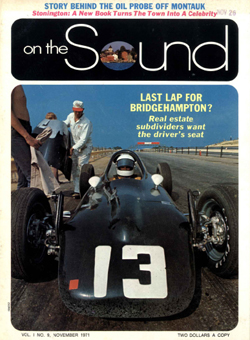
History continued...
The last major professional race at Bridgehampton was a Trans-Am, held in June, 1970 in a driving rainstorm. Mark Donohue, in a Javelin, walloped the factory Ford and Chevy entries. By then, hurricanes had devastated the track property and management was too cash-poor to make the repairs and necessary safety improvements to continue professional racing.
But worldwide publicity from the Bridgehampton races had greatly enhanced the popularity of the South Fork and Hamptons as a vacation destination. In an effort to share in this newfound windfall, a town-wide zoning revision broad-brushed most of the agricultural and undeveloped land for residential development, including the 10 square miles of forested ridge along Peconic Bay.
Inexcusably, town planners overlooked the long established recreational use of the Racetrack property which occupied nearly 600 acres atop the moraine. Against all established zoning principles, this demoted the race track to a non-conforming use which seriously hindered improvements to the property for recreation. It also raised the tax burden for farmers and the owners of undeveloped land which inevitably resulted in a gold rush for land speculators and house builders. In one fell swoop, the politicians had changed the primary engine of Southampton's economy from farming and tourism to land speculation.
Trorble on the horizon: noise complaints and encroaching development
 With new homes creeping ever nearer the track, noise complaints became a growing problem. The town government's knee-jerk reaction was to include the track in an anti-noise law aimed at discotheques and the like. In effect, this prohibited unmuffled professional events, the very essence of the circuit's attraction and its income base. Now the track had to enlist ever more amateur club races to pay the basic operating costs. The schedule quickly grew to full usage on every single weekend of the season, which only increased the noise complaints, even with sound level restrictions.In hindsight,limiting the racing schedule to fewer events each year would have been more effective for all concerned.
With new homes creeping ever nearer the track, noise complaints became a growing problem. The town government's knee-jerk reaction was to include the track in an anti-noise law aimed at discotheques and the like. In effect, this prohibited unmuffled professional events, the very essence of the circuit's attraction and its income base. Now the track had to enlist ever more amateur club races to pay the basic operating costs. The schedule quickly grew to full usage on every single weekend of the season, which only increased the noise complaints, even with sound level restrictions.In hindsight,limiting the racing schedule to fewer events each year would have been more effective for all concerned.
Meanwhile, the original BRRC shareholders were nearing retirement age and had never received a dime in dividends. During the 1970's, at the urging of a few influential absentee stockholders who wanted to cash in their chips, the Board of Directors finally consented to list their property in this lucrative real estate market.
Of course, "The Bridge" then became moribund while new and vastly more boring stadium-like venues were springing up around the country and the older racetracks were undergoing extensive modernization programs. Inevitably, the 1981 season opened on a sour note with the Lowenbrau Bridge collapsed in a ditch beside the paddock and a $3 Million purchase offer was put on the table from a condominium developer. That summer the Friends of Bridgehampton (later renamed the Bridgehampton Racing Heritage Group) was organized to urge the younger generation of enthusiasts to purchase the shares still held by nearly 1,000 elderly stockholders. In the meantime Carl Jensen, the track's jack of all trades, struggled to maintain the circuit in safe condition for the weekly amateur races.
